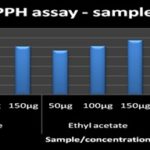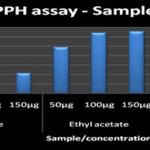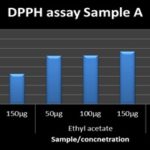PHYTOCHEMICAL ANALYSIS AND ANTIOXIDANT PROPERTY OF TRIGONELLA FOENUM, ZEA MAYS AND ORYZA SATIVA
HTML Full TextPHYTOCHEMICAL ANALYSIS AND ANTIOXIDANT PROPERTY OF TRIGONELLA FOENUM, ZEA MAYS AND ORYZA SATIVA
R. Krishnamoorthi and V. Ratha Bai *
PG and Research Department of Zoology, Presidency College (Autonomous), Chennai - 600005, Tamil Nadu, India.
ABSTRACT: Plants have been used for centuries as a remedy for human diseases because they contain phytochemical components of therapeutic values. The whole plant of the Trigonella foenum, Zea mays and Oryza sativa were selected for in this study to find out the phytochemicals and antioxidant property. Phytochemicals were extracted using various solvents such as Hexane, Ethyl acetate, and ethanol. Screening of phytochemicals showed positive results for the presence of flavonoid, alkaloid, phenols, coumarins, steroids, and quinones. Free radical scavenging activity was determined using DPPH is a stable antioxidant. Ethyl acetate extract of Zea mays showed better antioxidant activity at a concentration of 100-150 µg followed by ethanol extract. An ethanol extract of Trigonella foenum revealed antioxidant activity at a concentration of 100-150 µg followed by ethyl acetate extract. These activities may be due to the presence of flavonoid, alkaloid, phenols, and steroids in plant extracts. Antioxidant activity was not observed in Oryza sativa.
| Keywords: |
Trigonella foenum, Zea mays, Oryza sativa, DPPH, Antioxidant, Phytochemicals
INTRODUCTION: Phytochemicals are defined as bioactive nonnutrient plant compounds in fruits, vegetables, grains and other plant foods that have been linked to reducing the risk of major chronic diseases 1. The phytochemicals vary in distribution within the plant parts, as well as in their occurrence within plant species. Free radicals are known as major contributors to several clinical disorders such as diabetes mellitus, cancer, liver diseases, renal failure and degenerative diseases as a result of deficient natural antioxidant defense mechanism 2.
Antioxidants are the compounds which help to delay or inhibit the oxidation of lipids and other molecules through the inhibition of either initiation or propagation of oxidative chain reactions 3. Free radicals contribute to more than one hundred disorders in humans including atherosclerosis, arthritis, ischemia, reperfusion injury of many tissues, central nervous system injury, gastritis, cancer, and AIDS 4-5.
Free radicals are often generated as by-products of biological reactions or from exogenous factors. The involvements of free radicals in the pathogenesis of a large number of diseases are well documented 6. Medicinal plants can protect against harmful effects of ionizing radiation. Natural plant extracts or pure compounds are safe ingredients, which do not have any toxic effects. According to 7 plant extracts can be characterized by polyvalent formulations and interpreted as an additive or in some cases potentiating. First, the therapeutic benefit of medicinal plants is usually attributed to their antioxidant properties, and oxidative stress is a prominent feature of these diseases 8-9. Therefore, there is a need for isolation and characterization of natural antioxidants having less or no side effects, for use in foods or medicines to replace synthetic antioxidant.
The present work deals with the preliminary phytochemical investigation of various extracts (hexane, ethyl acetate, and ethanol) of the whole plant of Trigonella foenum, Zea mays, and Oryza sativa to identify the major group of photochemical and also identification of free radical scavenging activity using DPPH assay.
MATERIALS AND METHODS:
Collection of Plants: Plants for this study were collected from Chinnapaliyapattu, Tiruvannamalai.
Preparation of Extracts: Collected plants were dried at room temperature and ground to make a fine powder. 20 gm of plant powder was well dissolved in 100ml of solvents (Hexane, Ethyl acetate, and Ethanol) (ratio 1:5). The suspension was filtered by using Filter paper of pore size 0.2 µm. The filtrate was then air dried and extracts were collected in sterile vials for further use.
Phytochemical Tests:
Test for Carbohydrates: To 2 ml of plant extract, 1ml of Molisch’s reagent and a few drops of concentrated sulfuric acid were added. Presence of purple or reddish color indicates the presence of carbohydrates.
Test for Tannins: To 1 ml of plant extract, 2 ml of 5% ferric chloride was added. Formation of dark blue or greenish black indicates the presence of tannins.
Test for Saponins: To 2 ml of plant extract, 2 ml of distilled water was added and shaken in a graduated cylinder for 15 min lengthwise. Formation of a 1 cm layer of foam indicates the presence of saponins.
Test for Flavonoids: To 2 ml of plant extract, 1 ml of 2N sodium hydroxide was added. Presence of yellow color indicates the presence of flavonoids.
Test for Alkaloids: To 2 ml of plant extract, 2 ml of concentrated hydrochloric acid was added. Then a few drops of Mayer’s reagent were added. The presence of green color or white precipitate indicates the presence of alkaloids.
Test for Quinones: To 1 ml of extract, 1 ml of concentrated sulfuric acid was added. Formation of red color indicates the presence of Quinones.
Test for Glycosides: To 2 ml of plant extract, 3ml of chloroforms and 10% ammonia solution was added. Formation of pink color indicates the presence of glycosides.
Test for Cardiac Glycosides: To 0.5 ml of extract, 2ml of glacial acetic acid and a few drops of 5% ferric chloride were added. This was under layered with 1 ml of concentrated sulfuric acid. The formation of a brown ring at the interface indicates the presence of cardiac glycosides.
Test for Terpenoids: To 0.5 ml of extract, 2 ml of chloroform was added and concentrated sulfuric acid is added carefully. Formation of red-brown color at the interface indicates the presence of terpenoids.
Test for Triterpenoids: To 1.5 ml of extract, 1 ml of Liebmann-Buchard Reagent (aecticanhydride+ concentrated sulfuric acid) was added. Formation of blue-green color indicates the presence of triterpenoids.
Test for Phenols: To 1 ml of the extract, 2 ml of distilled water followed by a few drops of 10% ferric chloride was added. Formation of blue or green color indicates the presence of phenols.
Test for Coumarins: To 1 ml of extract, 1 ml of 10% NaOH was added. Formation of yellow color indicates the presence of coumarins.
Steroids and Phytosterols: To 1 ml of plant extract equal volume of chloroform is added and subjected with a few drops of the concentrated sulfuric acid appearance of brown ring indicates the presence of steroids and appearance of the bluish-brown ring indicates the presence of phytosterols.
Phlobatannins: To 1 ml of plant extract few drops of 2% HCl was added the appearance of red color precipitate indicates the presence of phlobatannins.
Anthraquinones: To 1 ml of plant extract, few drops of 10% ammonia solution were added, appearance pink color precipitate indicates the presence of anthraquinones.
Antioxidant Activity:
DPPH Free Radical Scavenging Activity: The ability of the extracts to annihilate the DPPH radical (1, 1-diphenyl-2-picrylhydrazyl) was investigated by the method described 10. A stock solution of leaf extracts was prepared for the concentration of 1 mg/ml. 100 µg of each extract were added, at an equal volume, to the methanolic solution of DPPH (0.1 mm). The reaction mixture is incubated for 30 min at room temperature; the absorbance was recorded at 517 nm.
The experiment was repeated for three times. BHT was used as standard controls. The annihilation activity of free radicals was calculated in % inhibition according to the following formula 10.
% of Inhibition = (A of control – A of Test) /A of control × 100
RESULTS: The highest yield of dried plant extracts was obtained from an ethanol extract of Oryza sativa (2.084 gms) followed by ethyl acetate extract (1.354). The yield of Zea mays by hexane, ethanol and ethyl acetate extracts were 0.21, 0.189 and 0.196 gms respectively. 0.21, 0.29 and 0.129 gms of dried extracts were obtained using hexane, ethyl acetate and ethanol extracts of Trigonella foenum respectively.
TABLE 1: VARIOUS EXTRACTS OF TRIGONELLA FOENUM, ZEA MAYS AND ORYZA SATIVA AND THEIR YIELD
| S. no. | Solvents | Yield (Grams) | ||
| Trigonella foenum | Zea mays | Oryza sativa | ||
| 1 | Hexane | 0.21 | 0.21 | 0.951 |
| 2 | Ethyl acetate | 0.29 | 0.184 | 1.354 |
| 3 | Ethanol | 0.129 | 0.196 | 2.084 |
The preliminary phytochemical screening of Trigonella foenum, Zea mays, and Oryza sativa showed the presence of plant components such as the flavonoid, alkaloids, phenolic compounds, coumarins, steroids, carbohydrates Table 1, 2 & 3.
TABLE 2: PHYTOCHEMICAL ANALYSIS OF TRIGONELLA FOENUM
| Test | Hexane | Ethanol | Ethyl acetate |
| Carbohydrates | - | - | - |
| Tannins test | - | - | - |
| Saponin test | - | - | - |
| Flavonoid test | + | + | + |
| Alkaloid test | + | + | + |
| Quinones | + | + | - |
| Glycosides test | - | - | - |
| Cardiac glycosides test | - | - | - |
| Terpenoids test | - | - | - |
| Triterpenoids | - | - | - |
| Phenols | + | + | + |
| Coumarins | + | - | + |
| Steroids and Phytosteroids | - | +&- | +&- |
| Phlobatannins | - | - | - |
| Anthraquinones | - | - | - |
TABLE 3: PHYTOCHEMICAL ANALYSIS OF ZEA MAYS
| Test | Hexane | Ethanol | Ethyl acetate |
| Carbohydrates | + | - | - |
| Tannins test | - | - | - |
| Saponin test | - | - | - |
| Flavonoid test | - | - | - |
| Alkaloid test | + | + | + |
| Quinones | + | + | |
| Glycosides test | - | - | - |
| Cardiac glycosides test | - | - | - |
| Terpenoids test | - | - | - |
| Triterpenoids | - | - | - |
| Phenols | + | + | + |
| Coumarins | + | - | + |
| Steroids and Phytosteroids | - | +&- | +&- |
| Phlobatannins | - | - | - |
| Anthraquinones | - | - | - |
TABLE 4: PHYTOCHEMICAL ANALYSIS OF ORYZA SATIVA
| Test | Hexane | Ethanol | Ethyl acetate |
| Carbohydrates | - | - | - |
| Tannins test | - | - | - |
| Saponin test | - | - | - |
| Flavonoid test | + | + | + |
| Alkaloid test | + | + | + |
| Quinones | - | - | - |
| Glycosides test | - | - | - |
| Cardiac glycosides test | - | - | - |
| Terpenoids test | - | - | - |
| Triterpenoids | - | - | - |
| Phenols | + | + | + |
| Coumarins | + | - | + |
| Steroids and Phytosteroids | - | +&- | +&- |
| Phlobatannins | - | - | - |
| Anthraquinones | - | - | - |
The phytochemical analysis of the hexane, ethyl acetate and ethanol extracts of Trigonella foenum and Zea mays showed positive results for the presence of Carbohydrates, flavonoids, alkaloids, phenols, steroids, coumarins. Ethyl acetate extract gave the maximum extraction of phytochemicals than some other extracts followed by Ethanol. In Zea mays, most prominent type of flavonols was glycosides of quercetin and isorhamnetin 11. Zea mays husk has analgesic and anti-inflammatory effects that are due to the presence of tannins and polyphenolic constituents 12. Our study also revealed that the whole plant extract of Zea mays showed the presence of phenolic compounds.
The phytochemical analysis of the hexane, ethyl acetate and ethanol extracts of Oryza sativa showed positive results for the presence of flavonoids, alkaloids, phenols, steroids, coumarins. Ethyl acetate extract of Oryza sativa gave the maximum extraction of phytochemicals than some other extracts followed by Ethanol.
Free Radical Scavenging Activity: The stable free radical scavenging activity by the DPPH method is an easy, rapid and sensitive way to survey the antioxidant activity of specific plant extracts. Fig. 1, 2 & 3 indicates the percentage of free radicals scavenging activity in various extractions with different concentrations (50-150 μg) of Trigonella foenum, Zea mays, and Oryza sativa. In this study percentage inhibition of free radicals was carried out with different extractions of selected plants. Ethyl acetate extract of Zea mays with 150 μg concentration gives a higher percentage (65.28%) of free radical scavenging activity followed by ethanol extract (61.47%). The lower level (16.48% - 21.17%) of free radical scavenging activity was noted in hexane extract.
Comparative studies on the crude hexane, ethyl acetate and ethanol extraction of Zea mays reported a higher percentage of scavenging activity in ethyl acetate and ethanol 1. The free radical scavenging activity increases with increase in concentration. At a concentration of 50μg/ml, ethyl acetate extract obtained 48.59% of free radical scavenging activity and got increased to 65.28% in 150μg/ml of concentration.
An ethanol extract of Trigonella foenum with 150μg concentration gives a higher percentage (62.94%) of free radicals scavenging activity followed by ethyl acetate extract (57.11%) and hexane extract (50.66%). Oryza sativa showed a low level of free radicals scavenging activity in all these three extracts range of (7.13% - 34.54%).
FIG. 1: ANTIOXIDANT ACTIVITY OF TRIGONELLA FOENUM BY DPPH ASSAY
FIG. 2: ANTIOXIDANT ACTIVITY OF ZEA MAYS BY DPPH ASSAY
FIG. 3: ANTIOXIDANT ACTIVITY OF ORYZA SATIVA BY DPPH ASSAY
CONCLUSION: This study suggests that the Trigonella foenum and Zea mays extracts have antioxidant activity, which may be helpful in preventing or slowing the progress of diseases involved as a result of oxidative stress.
ACKNOWLEDGEMENT: Nil
CONFLICT OF INTEREST: Nil
REFERENCES:
- Liu RH, Mahmoud and Tanabe H: J Nutri 2009; 134: 3479-3485.
- Parr A and Bolwell GP: Phenols in the plant and in man: The potential for possible nutritional enhancement of the diet by modifying the phenols content or profile. J Sci Food Agric 2008; 80: 985-1012.
- Jaleel CA: Antioxidant potentials and ajmalicine accumulation in Catharanthus roseus after treatment with gibberellic acid. Colloids and surfaces B: Biointerfaces, 2007; 60(2): 195-200
- Cook NC and Samman S: Flavonoids chemistry metabolism cardioprotective effects and dietary sources. Nutritional biochemistry 1996; 7: 66-76.
- Kumpulainen JT and Salonen JT: Natural antioxidants and anticarcinogens in nutrition, health and disease, (The Royal society of chemistry, UK) 1997; 178-187.
- Pourmorad F: Antioxidant activity, phenol and flavonoid contents of some selected Iranian medicinal plants. African journal of biotechnology 2009; 5(11): 1142-1145.
- Kulkarni RD: Principles of Pharmacology in Ayurveda, (Ram Sangram Graphics, Mumbai) 1997; 16.
- Feher J, Lengyel G and Blazovics A: Oxidative stress in the liver and biliary tract disease. Scandinavain Journal of Gastroenterology 1998; 33: 38-46.
- Aboutwerat A: Oxidant stress is a significant feature of primary biliary cirrhosis, Biochimica et Biophysica Acta: Molecular Basis of Disease 2003; 1637: 142-150.
- Blois MS: Antioxidant determinations by the use of a stable free radical. Nature 1958; 29: 1199-1200.
- Ceska O and Styles ED: Phytochem 2011; 23(8): 1822-1823.
- Bamidele V, Owoyele-Negedu M, Onasanwo SA and Oguntoye SO: J Med Food 2010; 13(2): 343-347.
How to cite this article:
Krishnamoorthi R and Bai VR: Phytochemical analysis and antioxidant property of Trigonella foenum, Zea mays and Oryza sativa. Int J Pharmacognosy 2014; 1(5): 321-26. doi: 10.13040/IJPSR.0975-8232.1(5).321-26.
This Journal licensed under a Creative Commons Attribution-Non-commercial-Share Alike 3.0 Unported License.
Article Information
7
321-326
602
2458
English
IJP
R. Krishnamoorthi and V. R. Bai *
PG and Research Department of Zoology, Presidency College (Autonomous), Chennai, Tamil Nadu, India.
mvragav444@yahoo.com
22 March 2014
24 April 2014
27 April 2014
http://dx.doi.org/10.13040/IJPSR.0975-8232.1(5).321-26
01 May 2014






